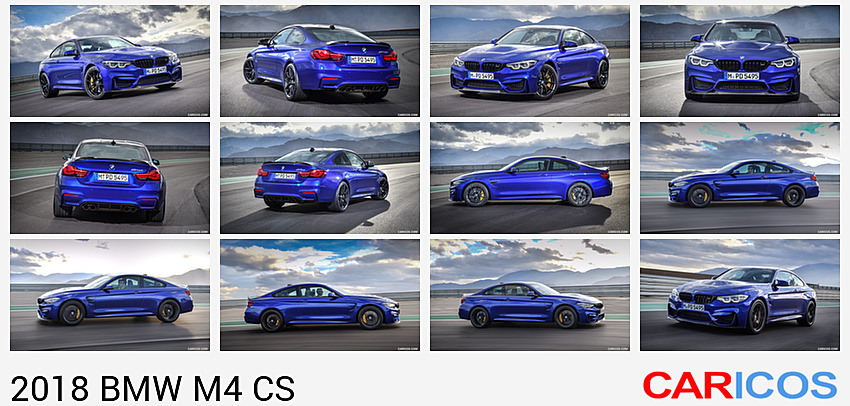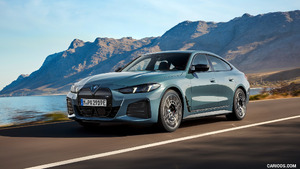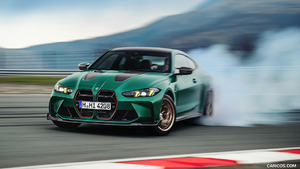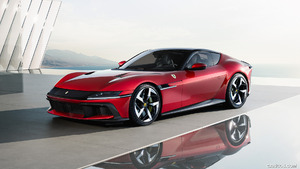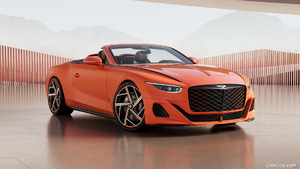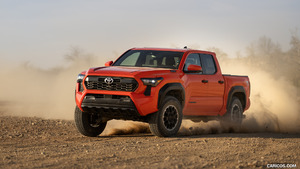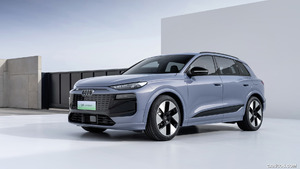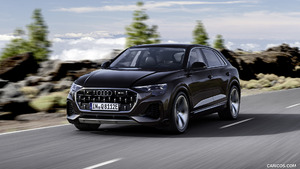2018 M4 CS
"BMW released a middle model between M4 Coupe with Competition Package and track-focused M4 GTS. The BMW M4 CS pulls 460 hp from its 3.0-liter twin-turbo engine, and reaches 62 mph from zero in 3.9 seconds. Top speed is electronically limited to 174 mph. For full specs and info check out the press release from BMW below:" Ed.
Sporting appeal and emotional richness running through every vein. High performance for the road, redefined.
The BMW M4 states its case as a compact high-performance coupe, the optional Competition Package gives it an extra edge, and the M4 GTS is an uncompromising sports car also designed for use on the track. And now the new limited-run special-edition BMW M4 CS fills the gap between its BMW M GmbH stablemates. With its eye-catching, emotionally powerful looks, it also raises the profile of the M4 range – and, by extension, the BMW M brand – another notch.
A new model-specific front splitter in exposed carbon fibre defines the face of the new BMW M4 CS, which cuts an unquestionably dominant and dynamic figure even when standing still. The car’s athletic lines extend along the CFRP bonnet and powerdome, over the roof – with its shallow central channel – and the new, likewise carbon-fibre spoiler lip on the boot lid, to the rear diffuser and its four exhaust tailpipes, integrated with impeccable stylistic fluency. The shape of the M4 CS appears as if cut from a single mould, underlining the design aspirations of the modern sports coupe.
The extensive use of carbon fibre-reinforced plastic (CFRP) ensures that the new BMW M4 CS is extremely light; indeed, its kerb weight is just 1,580 kilograms (acc. to EU, excl. driver). As well as the rear diffuser, large sections of the body are also made from CFRP. The bonnet, for example, is around 25 per cent lighter than that of the BMW M4 as a result. BMW’s many years of experience in the production of carbon-fibre components and carbon fibre-reinforced plastics has paid dividends with the new BMW M4 CS. Indeed, the CFRP roof is more than six kilograms lighter than a conventional metal item. Another benefit of this extremely light and yet highly robust composite material is the corresponding lowering of the car’s centre of gravity, which endows the BMW M4 CS with even more agile handling.
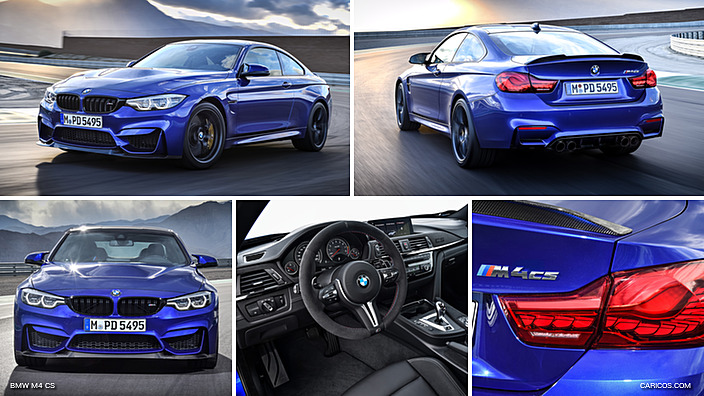 2018 BMW M4 CS
2018 BMW M4 CS
Unlike the BMW M4 GTS, BMW has deliberately steered the M4 CS away from a focus on the track. For example, the front splitter is not adjustable and instead of a large, adjustable wing, the rear end sports an exposed-carbon-fibre Gurney – i.e. an aerodynamic spoiler lip running across the trailing edge of the boot lid that significantly reduces rear-axle lift once again compared to the M4 with Competition Package. In the interests of everyday practicality, the M4 CS also forgoes the roll cage fitted in the M4 GTS.
The BMW M4 CS was honed at the Nürburgring Nordschleife, one of the world’s most exacting test tracks for high-performance sports cars – proof, if any were needed, that the new BMW M4 CS has been set up to deliver exceptional dynamics as well as unrestricted real-world usability. The M4 CS lapped the ’Ring in 7 min. 38 sec., which ranks it between the BMW M4 and the uncompromisingly track-focused M4 GTS.
The excellent dynamics of the new BMW M4 CS are rooted not only in a fresh round of suspension revisions over the M4 with Competition Package in terms of spring/damper settings, but also in a moderate increase in power for the six-cylinder in-line engine. Fitted in the M4 CS, it develops 460 hp – that’s 10 hp more than in the M4 with Competition Package. Peak torque increases by 50 Nm (37 lb-ft) to 600 Nm (442 lb-ft).
Generous use of Alcantara and leather has allowed the development engineers and designers at BMW M GmbH to conjure up an interior with an enviable sporting feel. Paring down the passenger compartment to the essentials and, in so doing, achieving significant weight savings was also the declared aim with the interior door panels and the side trim in the rear compartment. Both are made from compacted natural fibres – renewable raw materials, in other words – and have been given a special carbon-fibre look. Conventional door pulls give way to lightweight loops in the BMW M4 CS. And yet, despite the rigorously sporty mindset embodied by its cabin and also expressed in the presence of lightweight M sports seats, passengers in the BMW M4 CS need not go without niceties such as single-zone automatic climate control and a high-quality, specially adapted version of the HiFi System Professional.
A sensational straight-six engine. A commanding presence and phenomenal delivery.
The six-cylinder in-line engine has a great tradition at BMW, and in the new BMW M4 CS it is once again responsible for delivering performance par excellence. When compared to the M4 with Competition Package, maximum output has been increased by ten horsepower to 460 hp, which is on tap at 6,250 rpm. Peak torque of 600 Newton metres (442 lb-ft) is a whole ten per cent higher (M4 with Competition Package: 550 Nm / 405 lb-ft) and can be summoned up over a very wide rev range – from 4,000 rpm up to 5,380 rpm. These power reserves endow the new BMW M4 CS with supercar-like performance. The 0 to 100 km/h (62 mph) sprint is over in a breathtaking 3.9 seconds, for example. The top speed of the BMW M4 CS, which comes with the M Driver’s Package as standard, is electronically limited to 280 km/h (174 mph).
The high power output of the 3.0-litre engine can be attributed to its free-revving design, as well as the inclusion of two turbochargers and extremely effective charge air cooling. The M TwinPower Turbo technology at work in the BMW M4 CS employs two very responsive mono-scroll turbochargers, which combine with High Precision Injection, VALVETRONIC variable valve timing and Double-VANOS fully variable camshaft control to ensure the six-cylinder unit can deliver its power to maximum effect. Charge pressure is built up continuously from just above idling speed, while the fully variable valve and camshaft timing helps to maintain a high efficiency factor. This not only enables the engine to generate its power continuously over a very wide rev band, it can do so very economically, too. Fuel consumption and therefore exhaust emissions remain low (fuel consumption combined: 8.4 l/100 km* [33.6 mpg imp]; CO2 emissions combined: 197 g/km*). The high-revving ability of this exceptionally refined six-cylinder unit likewise benefits from VALVETRONIC and Double-VANOS technology. As a result, the straight-six under the bonnet of the BMW M4 CS has an impressively high rated engine speed for a twin-turbocharged unit of 7,600 rpm.
Thanks to its closed-deck design, the six-cylinder engine’s crankcase is remarkably rigid, paving the way for high cylinder pressures and very effective power output. The sleeveless cylinder walls, with their twin-wire, arc-sprayed coating, help to save weight. Another feature designed for top performance is the forged crankshaft boasting a lightweight design yet also high torsional strength. This keeps the rotating mass low and thereby makes the twin-turbo power unit even quicker to respond.
The engine’s oil supply system is another technical highlight, while also showcasing the vast motor sport expertise of BMW M GmbH. It has been designed with the tough demands of track racing in mind and makes sure the six-cylinder in-line engine is kept supplied with lubricant at longitudinal and lateral forces of up to 1.4 g. The lightweight magnesium oil sump is fitted with an additional cover to limit the lubricant’s surging movements, even during extreme driving manoeuvres such as abrupt changes of direction on a race track. An extra oil suction pump combines with a highly effective oil return system to ensure an unfailing supply of oil, even when performing extreme braking manoeuvres.
It goes without saying that an M power unit must come with the acoustics to match. In the new M4 CS, this is the task of a dual-branch sports exhaust system with a total of four tailpipes, which are neatly incorporated into the styling of the rear diffuser. Its exhaust back-pressure is as low as possible, something which is conducive to power build-up, and it is governed by a system of flaps. Positioned directly upstream from the rear silencers, the flaps are controlled electrically and are designed to provide optimum feedback on the engine’s load state throughout the entire rev range as well as generating that unmistakable, sporty M sound. The driver can alter the way in which the system of flaps works by preselecting a driving mode.
Power is transmitted to the rear wheels of the new BMW M4 CS via the seven-speed M Double-Clutch Transmission (M DCT) with Drivelogic that has already been successfully used in the M4 and M4 GTS models. The extremely fast gear changes mean there is no interruption in power flow, while the M Launch Control function ensures flawless acceleration from a standing start. The M DCT unit operates fully automatically, but there are also shift paddles on the steering wheel for changing gear manually. In order to cope comfortably with even the most demanding operating conditions, the seven-speed transmission comes with a dedicated oil cooler.
Superlative driving dynamics. Track-proven performance.
The models created by BMW M GmbH have always stood out by virtue of their supreme agility, steering precision and handling stability. The new BMW M4 CS upholds this tradition, while also catering to the sports-minded driver with a variety of settings options for the suspension, the M Servotronic electromechanical steering, the DSC stability control system and the seven-speed M Double-Clutch Transmission with Drivelogic.
The new BMW M4 CS is fitted as standard with Adaptive M suspension, offering the driver the choice between Comfort, Sport and Sport+ modes, with different damper settings in each of the three modes. Whereas the Comfort setting maximises ride comfort while driving in the city, for example, Sport mode allows country roads to be negotiated with a highly dynamic flourish. And if the M4 CS is taken on an outing to a race track, Sport+ activates the firmest suspension set-up, resulting in minimal body movement and unbeatable dynamics.
Three different performance maps for the wonderfully precise electromechanical steering in the M4 CS can also be called up at the touch of a button. The steering’s remarkably sensitive responses vary in the Comfort, Sport and Sport+ modes, while the level of power assistance is also modified, allowing the steering characteristics to be adapted to the type of journey and the driver’s personal tastes.
The high-tech package of chassis technology for the new BMW M4 CS also includes the Active M Differential, whose electronically controlled multi-disc locking action further enhances the already outstanding traction and driving stability. To do so, the multi-disc limited-slip differential’s control unit communicates with the DSC (Dynamic Stability Control) system. It also factors in the accelerator position, the rotational wheel speeds, and the yaw rate of the M4 CS, and adapts to the changing driving situation with extreme precision and at lightning speed. The Active M Differential is therefore able to detect the imminent loss of grip on one side of the car, for instance, and adjust the locking torque accordingly to produce a locking effect between zero and 100 per cent. When the car is being put through its paces on a circuit, in particular, the driving stability features thereby ensure optimum traction under all conditions, such as when powering out of tight turns or on surfaces with differing levels of grip.
Dynamic Stability Control (DSC) normally counters understeer or oversteer by means of targeted intervention in the engine and brake control systems. In the case of the M4 CS, engaging M Dynamic Mode (MDM) allows a greater degree of wheel slip, making it possible to perform mild drifts. This is the sort of manoeuvre drivers seeking particularly sporty and dynamic responses will enjoy, especially on the track. In this mode, they are entirely responsible for stabilising the vehicle.
The new BMW M4 CS’s chassis is largely the same as that of the BMW M4 with Competition Package. Notable features include its low weight – a result of its lightweight aluminium construction – and the extraordinary rigidity of the axle systems. There is a lightweight double-joint spring strut axle at the front and a five-link axle at the rear. The links and wheel carriers are all made from forged aluminium. Ball joints with zero play and elastomeric bearing purpose-developed for the M4 ensure direct transmission of power without any play both longitudinally or laterally, resulting in an extremely responsive chassis and consequently excellent driving dynamics. The rear differential’s double-elastic suspension and the rear axle subframe’s rigid bolted connection with the body structure both demonstrate how thoroughbred motor sport technology has been engrained into the BMW M4 CS.
A new, forged light-alloy wheel option in Orbit Grey has been specially developed for the new BMW M4 CS. Its ten-spoke design takes its cues from the wheels of the successful M4 cars competing in the German Touring Car Masters (DTM) race series. The BMW M GmbH engineers have rigorously applied their lightweight design approach to the wheels as well. The 10 J x 20-inch wheels at the rear weigh no more than around ten kilograms each and their 9 J x 19-inch counterparts at the front a mere nine kilograms or so. That keeps the unsprung masses low, which is another factor in the exceptionally dynamic handling of the M4 CS. The M4 CS rides as standard on mixed-size Michelin Pilot Sport Cup 2 tyres (265/35 R 19 at the front and 285/30 R 20 at the rear). The cup tyres are designed to transfer the steering forces to the road surface with incredible precision, while also providing the driver with as much feedback as possible. They are eminently suited to track use and offer maximum grip. Drivers looking to keep their M4 CS mainly for everyday use, though, can opt for the Michelin Pilot Super Sport tyres instead, which generate more grip on wet roads than the Cup tyres.
Like the M4, the new M4 CS comes with BMW M compound brakes as standard. Four-piston callipers at the front and two-piston units at the rear are employed to deliver outstanding stopping power, high fade resistance and excellent controllability. Compound brakes are far lighter than a conventional braking system, meaning a further reduction in unsprung masses and thus even sharper handling. The BMW M4 CS is optionally available with BMW M carbon ceramic brakes. These feature six-piston callipers at the front and four-piston callipers at the rear, are even lighter, withstand the sort of extreme loads experienced in race action on a track and are even more durable as well. All settings for the DSC, ABS, Adaptive M suspension, Active M Differential, seven-speed M Double-Clutch Transmission and M Servotronic steering have been modified for the new BMW M4 CS and tailored to the specific requirements of this compact high-performance sports car.
Unmistakable M styling. A highly emotive design language inspires striking looks.
The new BMW M4 CS special-edition model leaves no doubt as to its performance capabilities with its looks alone. No matter which angle the M4 CS is viewed from, it appears as if cut from a single mould, has a muscular, athletic air and makes it perfectly clear – even when standing still – that here is a high-performance sports car. In other words, the M4 CS is another uncompromising expression of the BMW M design language intended to communicate its exceptional performance and exhibit all of its emotionally rich, intensely dynamic character at first glance. The front end, with its pronounced three-dimensional contouring, oozes sportiness from every pore. Distinguishing features include the twin headlight units with their state-of-the-art LED technology and the slender double-kidney grille with black-painted bars. The front apron is divided into three parts and brings the dynamic nature of the new BMW M4 CS even further to the fore, at the same time as performing its technical functions. The large air intakes provide highly efficient cooling for both the twin-turbo six-cylinder engine and the powerful braking system.
The design of the front splitter is exclusive to the BMW M4 CS special-edition model. Made from lightweight exposed carbon fibre, it reduces lift at the front axle to great effect. The bonnet is also made from lightweight carbon fibre-reinforced plastic (CFRP) and is crowned by a distinctive powerdome. This isn’t just an eye-catching design feature, either. It too fulfils an important function by creating space for the high-performance engine’s charge air cooler, and its air vent also allows effective dissipation of the heat produced. The powerdome’s outline is picked up by the roof’s contoured middle section before continuing down the boot lid all the way to the prominent tail.
The new BMW M4 CS is a visual expression of all-out sportiness when seen in profile, too. The dominant stylistic elements here include a long bonnet, long wheelbase and a short front overhang. One of the dominant stylistic features in this area of the car is the aerodynamic styling of the sporty-looking M exterior mirrors, with their simulated twin-arm design, which seem to be almost floating gracefully in the air. The flowing roofline, meanwhile, lends added emphasis to the coupe character of the M4 CS. The muscular and, especially at the rear, powerfully accentuated wheel arches likewise make a striking contribution to the exceedingly sporty aura of the M4 CS, their width underlining its dynamic prowess.
Moving to the rear, the eye is instantly caught by the restyled Gurney made from exposed carbon fibre. Apart from providing a sporty visual highlight, this aerodynamic spoiler lip also has an important function; it reduces rear axle lift, which in turn helps to optimise roadholding and traction. The top edge of the Gurney is contoured slightly in a similar fashion to the roof. As on the BMW M4 GTS, the distinctive rear lights on the BMW M4 CS are designed entirely using pioneering OLED (Organic Light Emitting Diode) technology and produce a fascinating 3D effect.
The rear diffuser is carried over from the BMW M4 GTS. It adds a very striking and sporty flourish to the rear end and seamlessly incorporates the four stainless-steel tailpipes (all bearing the M logo) of the dual-branch flap-controlled exhaust system into its styling. In keeping with the motor racing pedigree of BMW M GmbH, the diffuser and front splitter optimise the airflow along the vehicle’s underbody, helping to keep the car in even better contact with the road.
The new BMW M4 CS also comes with the BMW Individual High-gloss Shadow Line trim with extended features already familiar from the M4 with Competition Package. This means features such as the side window trim and window recess covers are finished in high-gloss black, as are the BMW kidney grille and the prominent M gills on the front wings. The model badge on the tail is in silver chrome.
BMW M GmbH is offering two new colours exclusively for the new BMW M4 CS special edition: San Marino Blue Metallic and Lime Rock Grey Metallic. Anyone seeking a particularly exclusive and eye-catching look can also opt for Frozen Dark Blue II, a matt blue finish created by the specialists at BMW Individual. The elaborate painting process means that Frozen Dark Blue II (expected to become available in November 2017) will be restricted to a limited number of cars.
The light-alloy wheels in Orbit Grey have likewise been designed specifically for the new M special-edition model. Both extremely rigid and incredibly light, the wheels feature a ten-spoke arrangement that affords a clear view of the large brake discs and brake callipers behind, the latter with either a blue painted (BMW M compound brakes) or gold anodised (M carbon ceramic brakes) finish. The wheel design is closely modelled on that of the successful BMW M4 DTM racing cars.
Equipped to the highest standard. Sportiness and driving comfort in perfect harmony.
The cabin of the BMW M4 CS is awash with fine leather and classy Alcantara. Both the driver and front passenger settle into the same specially-designed lightweight M sports seats fitted in the M4 with Competition Package. They are upholstered in Merino leather and Alcantara and guarantee optimum lateral support, even when powering around a track. At the same time, though, they are also very comfortable on long journeys. The familiar BMW M stripes have been incorporated into the front seat belts.
The most important accessory for drivers of the new BMW M4 CS is, needless to say, an M sports steering wheel. The M Alcantara steering wheel – a cost option – is wrapped in exclusive, anthracite-coloured Alcantara with blue/red M stitching and a 12 o’clock marker, and provides outstanding grip in all driving situations.
The interior trim strips are lined with Alcantara and feature prominent CS identifiers. Alcantara is a wonderfully classy yet hard-wearing upholstery material that also graces the lightweight centre console and the elbow rests in the door panelling. When it comes to the door panelling and the side sections in the rear, BMW M GmbH has taken the same groundbreaking approach as it did for the M4 GTS. These elements are made from compacted natural fibres – renewable resources in other words – and are considerably lighter than conventional door panels. The engineers have also given the surface of the door panelling a smart carbon-fibre look. There is plenty of badging to further underline the status of the new BMW M4 CS special-edition model. An illuminated M4 logo has been integrated into the backrests of the M sports seats and there are special door sill strips inscribed with M4 CS lettering.
Despite the intensely sporty focus of the new BMW M4 CS, drivers do not have to go without comforts such as single-zone automatic climate control. An advanced version of the BMW HiFi system Professional provides superb listening pleasure, and the BMW Navigation system Professional is also to be found on the extensive list of standard comfort features. Adaptive LED Headlights including BMW Selective Beam (dazzle-free high beam assistant) can be ordered as an option. The intelligent BMW ConnectedDrive Services are also available as an option, as is the BMW M Laptimer app, which can be used for recording all the details of laps around a race track, for example. Plus, almost all of the myriad other options available for the BMW M4 can also be specified for the M4 CS.
Following in a long tradition of BMW M3 special editions. Harder-edged versions of the M3 have being thrilling drivers for roughly 30 years.
The BMW M3 has a long tradition of special-edition models passing muster as pure-bred sports cars but also offering full everyday usability. It goes without saying that this is also an attribute displayed by the BMW M4, the sporting poster boy for the BMW 4 Series model range unveiled in 2013. At the start of 2013, the BMW 4 Series succeeded the BMW 3 Series Coupe and 3 Series Cabriolet as a standalone model range and has made a name for itself with its particularly dynamic and elegant appearance.
1988: The BMW M3 Evolution (E30). The founding father of the BMW M3/M4 family is the E30 BMW M3, which in 1986 set the benchmark for a nascent breed of compact high-performance cars also boasting impressive everyday practicality. It was followed not long after by the first special edition: 1988’s BMW M3 Evolution. The high-revving, 2.3-litre four-cylinder in-line engine under this particular bonnet developed 162 kW/220 hp – 25 hp more than in the standard M3. Limited to a production run of 500 units, the M3 Evolution can be identified by its larger front spoiler and adjustable rear spoiler. The crowning glory of the E30 3 Series arrived in 1990 in the shape of the BMW M3 Sport Evolution with 2.5-litre four-cylinder engine producing 175 kW/238 hp. The M3 Sport Evo has since established itself as a rare, classic sports car with a fan club and price tag to match.
1994: The BMW M3 GT (E36). In 1992 the M3 version of the second-generation BMW 3 Series (the E36) welcomed the arrival of BMW’s now legendary six-cylinder in-line engine, initially in 3.0-litre form and later with 3.2-litre displacement. The E36 3 Series again spawned a special-edition model; the M3 GT – of which only 350 examples were built – arrived to considerable fanfare in 1994. It developed 217 kW/295 hp, boasted four-valve technology and VANOS camshaft timing on the intake side, and offered breathtaking performance. Indeed, it was capable of 0-100 km/h (62 mph) in just 5.9 seconds. The doors of the M3 GT had a lightweight aluminium construction. And its engine offered an early preview of technical details featured in the 3.2-litre straight-six that was waiting in the wings.
2003: The BMW M3 CSL (E46). The next-generation M3, the standard-bearer for the E46 3 Series, duly delivered another sensation – in the form of the 2003 M3 CSL. The extra letters attached to this special edition served as a reminder of the legendary BMW 3.0 CSL from the early 1970s. A weight-saving boot lid with integral spoiler lip, a rear window with thin glass and various parts made from carbon fibre-reinforced plastic (CFRP) – such as the centre console, door trim and rear-view mirror – helped to make the M3 CSL 165 kilograms lighter on the scales than the regular E46 M3 Coupe. When it came to engine output, though, the M experts added rather than taking away. The 265 kW/360 hp high-revving 3.2-litre straight-six was a brilliant example of its kind, firing the M3 CSL from 0–100 km/h (62 mph) in a mere 4.8 seconds. And its 7 min. 50 sec. lap of the Nürburgring Nordschleife was the fastest of any car in its output class at the time. Just under 1,400 examples of the M3 CSL special edition left the factory.
2010: The BMW M3 GTS (E92). M GmbH had already served notice of the direction the next generation of its iconic sports car would take with the 2001 M3 GTR. That direction was towards eight cylinders. The M3 GTR was developed as the base model for an entry in the American Le Mans Series (ALMS) GT race series. But a change in the regulations put the brakes on the plan. The V8 finally took up its place – with four-litre displacement – in the agile high-performance sports car in 2007; the fourth-generation M3 (E90/E92) was born. We now fast-forward to 2010 and the arrival of the spectacular M3 GTS, a bona fide successor to the M3 CSL. An increase in engine displacement to 4.4 litres handed the V8 an impressive 331 kW/450 hp, enough to catapult the M3 GTS from 0 to 100 km/h (62 mph) in 4.4 seconds. The top speed of this exclusively built-to-order sports car from BMW M GmbH was 305 km/h (189 mph). 2011: The BMW M3 CRT (E92). With only 67 examples ever made, the 2011 M3 CRT is another very special M3 which – like all M3 special editions – has the makings of a classic. The CRT built on the technical foundations of the M3 GTS Coupe, but is actually a four-door sedan with two moulded individual seats in the rear. The CRT brought the BMW M3 full circle, the original E30 M3 also classing itself as a sedan (albeit it one with only two doors).
2016: The BMW M4 GTS (F82). Presented in 2015, produced from 2016 as a limited-run special edition and adopting the new M4 model designation, the M4 GTS provided the next instalment in the impressive history of M3/M4 variants fettled to deliver uncompromising sports performance and dynamics. The M4 GTS also formed part of BMW M GmbH’s celebrations marking 30 years of the successful and dynamic M3/M4 family.

